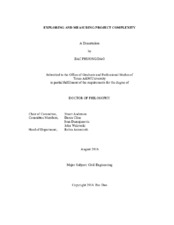| dc.description.abstract | Project complexity is a term that is not well understood in the construction industry in relation to academia and practice. Project complexity often refers to a measurement of the number of project elements and interactions between project elements or a relative comparison of difficulty to what was previously accomplished. Project complexity is a very critical factor that presents additional challenges to achieving project objectives. Impacts of project complexity can be negative if it is not assessed and managed appropriately. Developing a methodology to assess and measure project complexity can help project teams increase the likelihood of success and predictable project outcomes. This research proposed a constructive approach to assess and measure project complexity as a separate factor influencing projects including a model that helps identify the levels of project complexity. In this research, first, the concepts of complexity and its attributes were explored, and the literature relevant to defining and assessing project complexity was studied. A working definition of project complexity was then developed as a basis for describing project complexity. Project complexity was intentionally described in terms of managing projects rather than project physical features such as facility technology, types of materials, or project physical components to ensure that the research results could be generalized across a wide range of industry sectors. The possible project complexity attributes were then identified using complexity theory variables, the literature review results, and industry experience. The identified complexity attributes were used to develop the complexity indicators deemed to measure the associated attributes. The developed complexity indicators were then converted to survey questions for data collection purpose. The collected data was analyzed using statistical methods to test the significance of complexity indicators in differentiating low complexity projects from high complexity projects. The research result showed that thirty-seven complexity indicators associated with twenty-three complexity attributes were significant. These significant complexity indicators were considered to be truly representative of project complexity. The thirty seven significant indicators were then used as the input for the model development process.
The model developed in this research is a binary logistic regression that predicts the probability of high complexity or low complexity given the values of complexity indicators. In the research, the multivariable analysis was used as the method to develop the model, and the univariate method was used as an approach to selecting a subset of explanatory variables. The univariate method resulted in a set of 27 complexity indicators out of 37 initial significant indicators that functioned as the measures of project complexity. To generate the required input for the proposed model, the variable reduction process called Principle Component Analysis (PCA) was applied during the model development process to reduce the number of explanatory variables. PCA process resulted in a significantly smaller number of principal components functioning as the moderating variables in the model (10 PCs). However, this number of moderating variables was still not small enough to create a stable model. Therefore, the univariate method was applied the second time to the set of principle components. The second application of univariate method resulted in the final set of 8 principle components. Those principle components functioned as the final set of moderating variables in the developed model as it was sufficient to generate a stable model. This process helped in generating a numerically stable model while the subject observations were limited. The developed model helps scholars and practitioners in the field of project management assess complexity level of a project based on the applicably identified complexity measures. Given the identified complexity levels, project practitioners can facilitate the management process and formulate a management plan by applying an appropriate complexity management strategy. | en |


